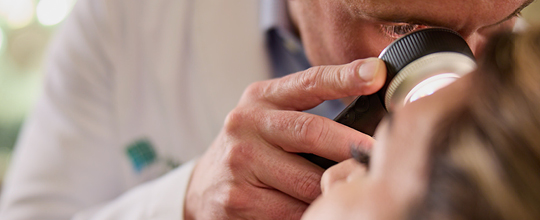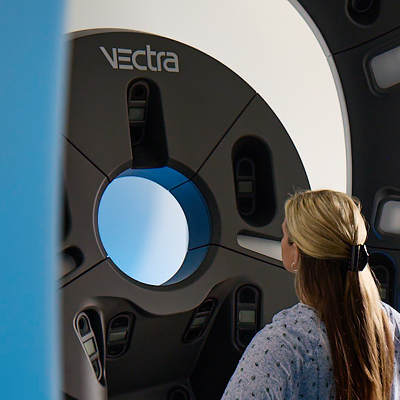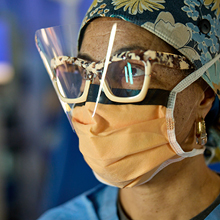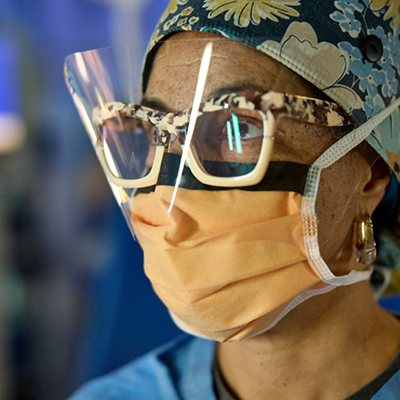Squamous cell skin cancer is the second most common type of skin cancer and has a higher risk of spreading. AHN is here to help walk you through your diagnosis and treatment plan.

What is squamous cell skin cancer?
Squamous cell skin cancer (SCC) develops in the flat, thin cells that make up the outer layer of your skin. It is the second most common type of skin cancer after basal cell carcinoma but is generally more aggressive.
Squamous cell skin cancer presents differently than other skin cancers. It often appears as a firm, red, scaly bump that might bleed or crust over and might feel sore or tender. It can also appear as an open sore or as a wart-like growth. Melanoma usually appears in multiple colors and has irregular borders. Basal cell carcinoma can be a pearly or waxy flesh-colored bump.
AHN is here to treat your unique case with precision and care.
Skin Cancer Center of Excellence
The AHN Melanoma and Skin Cancer Center of Excellence is unlike any other skin cancer center in the area. Our dedicated team of dermatologists, oncologists, oncodermatologists, and medical professionals are all working in tandem to provide the most comprehensive and compassionate care to our patients.
With a team of expert providers and state-of-the-art technology we’re able to provide comprehensive skin cancer screening, diagnostic services, and specialized care for high-risk patients all in one setting to ensure consistent and thorough care.
Why choose AHN for skin cancer treatment?
At the AHN Cancer Institute, you’re never alone. We see you as not only a patient, but as a person who needs individualized treatment and care. This means you can expect care for your Squamous cell skin cancer treatment that is:
- Personalized: Our skilled team of dermatologists, oncologists, pathologists, and surgeons offer the latest targeted, minimally invasive surgeries or therapies pinpointed to the type of skin cancer you have.
- Patient-centric: Our Navigation Team helps coordinate appointments, answers questions about symptoms and treatment options, and provides support if you need to travel. We help lift the burden of logistics so you can focus on getting better.
- Compassionate: Cancer treatment is a stressful time. Our compassionate team of caregivers is devoted to improving your quality of life, helping you understand treatment options, and keeping you comfortable every step of the way. Our robust, comprehensive support services help you live the best quality of life during treatment.
- Collaborative: Your care team — AHN surgeons, dermatologists, oncologists, and other medical professionals — collaborate on your treatment plan and work to identify what is best for your specific case.

Quick guide to squamous cell skin cancer
Squamous cell skin cancer symptoms
Squamous cell skin cancer screening and diagnosis
Types and stages of squamous cell skin cancer
Squamous cell skin cancer symptoms
Performing regular skin checks for yourself and noticing any changes can help spot early signs of skin cancer. Early detection of Squamous cell skin cancer symptoms can lead to better outcomes and reduce the risk of the cancer spreading.
If you notice any of the following skin changes, contact your doctor as soon as you can.
Squamous cell skin cancer (SCC) may look like or show up on your skin as:
- A firm, red nodule: This is often the first sign of SCC.
- A flat, scaly patch: This may be red, brown, or flesh-colored.
- A sore that doesn't heal: This may be crusty, scabby, or bleed easily.
- A change in the size, shape, or color of a mole: This can be a sign of SCC or another type of skin cancer.
Actinic keratosis
Actinic keratosis (AK) is a common precancerous skin condition caused by prolonged and excessive sun exposure. It is characterized by rough, scaly patches that can appear on sun-exposed areas of the skin, such as the face, ears, neck, scalp, hands, and forearms. Actinic keratosis can develop into squamous cell carcinoma making regular skin screenings important.
Squamous cell skin cancer risk factors
If you have any combination of the following risk factors, you may be at greater risk for developing squamous cell skin cancer (SCC). Although not everyone with these risk factors will develop SCC, it is important to speak with your doctor to determine what skin cancer screening looks like for your needs and risk factors.
- Sun exposure: This is the most significant risk factor. Excessive sun exposure, especially during childhood and adolescence, increases your risk of SCC.
- Tanning beds and sunlamps: These emit UV radiation, which is just as harmful as the sun.
- Fair skin, freckles, and light hair: People with these characteristics are more susceptible to sun damage.
- Family history of skin cancer: Having a close relative with SCC increases your risk.
- Weakened immune system: Conditions like HIV/AIDS or organ transplantation can suppress the immune system, making you more vulnerable to SCC. SCC is the most common skin cancer in solid organ transplant recipient patients.
- Certain skin conditions: People with conditions like xeroderma pigmentosum or albinism are at higher risk.
- Exposure to certain chemicals: Some chemicals, like arsenic and coal tar, can increase the risk of SCC.
- Smoking: Smoking is linked to an increased risk of SCC, particularly on the lips and head.
- Age: The risk of SCC increases with age.
Squamous cell skin cancer screening
Everyone should get regular skin checks, especially those with a higher risk of squamous cell skin cancer. This includes people with fair skin, a family history of skin cancer, and those who have had excessive sun exposure. The frequency of screenings depends on your individual risk factors. Your doctor can advise you on how often you should get screened. We offer monthly cancer screenings across Pennsylvania. Find AHN cancer screening dates, locations, and eligibility near you.
Squamous cell skin cancer diagnosis
During a skin check, your dermatologist will look for suspicious marks that could indicate a squamous cell skin cancer diagnosis. Your AHN dermatologist will use a variety of techniques to determine the diagnosis.
A physical exam
A physician, often a dermatologist, examines your skin to look for suspicious growths. Squamous cell carcinomas tend to appear as a firm bump called a nodule. The nodule can be skin-colored, pink, red, or black — depending on skin color, but there are other signs and symptoms your doctor will look for during the exam.




Mole mapping
This procedure uses full-body photographs of your skin to monitor changes in existing moles and to detect new ones. Physicians use this cutting-edge preventive measure at your annual skin exam. It’s especially helpful for tracking moles for high-risk individuals, such as those with a family history of squamous cell skin cancer.
Biopsy
We remove a small amount of tissue from your skin for examination under a microscope. A biopsy can determine if cancer is present. During a biopsy, we give you an anesthetic so you will be comfortable.
Biopsy procedures include:
- Shave biopsy, using a tool similar to a razor.
- Punch biopsy, using a circular tool that removes a small section of skin.
- Excisional biopsy, using a scalpel to remove an entire lump.
Types of squamous cell skin cancer
Squamous cell skin cancer (SCC) is classified into different types based on its appearance and growth pattern. Only a dermatologist can accurately diagnose this type of cancer. Since there are similarities between the different SCC types, it’s important to see your dermatologist so they can better assess the area of concern. Using mole mapping, skin checks, and other tests, your doctor can determine if it’s a squamous cell skin cancer diagnosis.
Squamous cell carcinoma in situ
Sometimes also called Bowen’s disease, squamous cell carcinoma in situ may appear as a flat, scaly, or crusted patch of skin that may be red, brown, or flesh-colored. The growth is confined to the top layer of skin (epidermis) and does not invade deeper tissues. It’s often found on the face, ears, hands, and feet. Most treatment decisions are based off tumor differentiation with poorly differentiated tumors being more aggressive and more likely to spread than well-differentiated tumors.
Verrucous squamous cell carcinoma
A large, warty growth that may be cauliflower-like in appearance, it is found on the hands, feet, and genitals. This type of cancer is slow-growing and rarely metastasizes. Despite its slow-growing nature, seeing your doctor if you notice skin changes is still important so they can monitor it.




Keratoacanthoma
This type of cancer is often found on sun-exposed areas of the skin. It is a rapidly growing, dome-shaped nodule with a central crater. Despite how quickly the nodules appear and grow, they are usually less aggressive in terms of metastasizing. It’s still very important that you see your health care provider if you notice changes in your skin, new moles, or new growths.
Stages of squamous cell skin cancer
Squamous cell carcinoma (SCC) is staged based on the size and spread of the tumor. The most common staging system used is the TNM system, which stands for:
- T (Tumor): Describes the size of the primary tumor.
- N (Nodes): Indicates whether the cancer has spread to nearby lymph nodes.
- M (Metastasis): Indicates whether the cancer has spread to distant parts of the body.
There are five SCC stages:
- Stage 0 (Carcinoma in situ): The cancer is confined to the top layer of skin (epidermis) and has not invaded deeper tissues. It has not spread to lymph nodes or distant parts of the body.
- Stage I: The tumor is 2 centimeters or smaller in diameter. It has not spread to lymph nodes or distant parts of the body.
- Stage II: The tumor is larger than 2 centimeters but not larger than 4 centimeters. It has not spread to lymph nodes or distant parts of the body.
- Stage III: The tumor is larger than 4 centimeters or has spread to regional lymph nodes. This would also include tumors that have invaded underlying tissue beyond the skin.
- Stage IV: Tumor can be any size and has spread to lymph nodes and distant parts of the body.
Sub-staging
Each stage can also be broken out into additional sub-stages based on the specific characteristics of the tumor, such as its depth of invasion or the number of lymph nodes involved.
Squamous cell skin cancer treatment
After discussing the risks and benefits of treatment options, your doctor will recommend what’s best for you.
Your cancer treatment options depend on the size, location, and depth of the tumor. We also consider your overall health when planning your squamous cell skin cancer (SCC) treatment.
Early-stage SCC is often treated with surgery, while advanced-stage SCC may require a combination of treatments, such as surgery, radiation therapy, and chemotherapy.
There are different treatment options for squamous cell skin cancer (SCC) and basal cell carcinoma (BCC). Your doctor can explain more about what may work best for you, but we’ve briefly described some different options so you can go into the conversation with some information:
- Surgical margins: These refer to the tissue surrounding a tumor that is removed during surgery. BCC often requires smaller surgical margins than SCC due to its slower growth and lower risk of metastasis.
- Mohs surgery: This surgery is a specialized technique used to remove certain skin cancers. While both BCC and SCC can be treated with Mohs surgery, it is more commonly used for SCC due to its higher risk of recurrence.
- Radiation therapy: Radiation therapy is more frequently used for SCC than BCC, especially for advanced or recurrent tumors.
- Chemotherapy: Chemotherapy is rarely used for BCC but may be necessary for advanced SCC.




Surgery
An upcoming skin cancer surgery can bring questions. Rest assured, your AHN surgeon has the answers and is part of team of collaborative health care professionals focused on delivering the most personalized care. AHN uses the latest, most cutting-edge technologies and procedures to perform minimally invasive surgeries
Skin cancer surgeries for SCC include:
- Excision: This is the most common treatment for SCC. The cancerous tissue and a small margin of healthy skin around it are surgically removed.
- Mohs surgery: This specialized technique is used for SCCs that are located in delicate areas, such as the face or eyelids. It involves removing the tumor layer by layer until clear margins are achieved.
Radiation therapy
Radiation is another option when surgery isn’t feasible for large tumors or with those who are not good candidates for surgery. Radiation therapy can also be necessary when the SCC tumor has invaded underlying nerves in a process called perineural invasion (PNI).
Radiation therapy options for this skin cancer includes:
- External beam radiation therapy: This involves using high-energy X-rays to destroy the cancerous cells.
Topical medications and intralesional therapy
This noninvasive treatment approach is indicated in the treatment of squamous cell carcinoma in situ disease that has not gone deeper than the top layer of skin (stage 0). It may also be the next option for patients who are not candidates for surgery. Intralesional therapy involves injecting chemotherapy directly into the skin cancer lesion itself and not in the bloodstream. This is typically reserved for tumors and patients who are not candidates for surgery. In addition to being effective, it is also much safer than systemic chemotherapy.
Common topical medications used to treat SCC include:
- Imiquimod cream: This medication stimulates the immune system to fight the cancer cells.
- Fluorouracil cream: This medication is a chemotherapy drug that destroys the cancerous cells.




Photodynamic Therapy
This involves applying a photosensitizing drug to the tumor and then exposing it to a specific wavelength of light. The drug makes the cancer cells more sensitive to light, which destroys them.
Immunotherapy
Typically this treatment uses immune checkpoint inhibitors to boost the body’s immune system and fight the cancer cells.
Chemotherapy
This is less commonly used in SCC treatment today. Traditional chemotherapy selectively kills tumor cells. Immunotherapy and targeted therapy options have largely replaced chemotherapy. In rare cases, SCC may spread to other parts of the body (metastasize). In these situations, chemotherapy may be used to slow the growth of the cancer.
Follow-up Care
After treatment, you will need regular follow-up appointments with your dermatologist to monitor for any signs of recurrence. It’s important to protect your skin from the sun to reduce the risk of future SCCs.
Call the Hope Line at (412) 578-HOPE (412) 578-4673 to connect with a nurse navigator or schedule an appointment.

